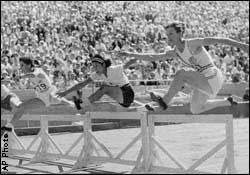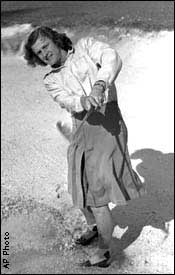

From ESPN's Classic Sports
Back in a time when it was considered unfeminine to take sports too seriously, Babe Didrikson Zaharias was brazenly athletic. And the 1932 Olympic champion, who went on to a career in professional golf, made sure everyone knew it.
 | |
| Didrikson clears a hurdle en route to her world record
time in the 80-meter hurdles at the 1932
Olympics. |
"I had played years ago with Babe and Sam Snead," said Peggy Kirk Bell. "And she'd hit it right out with Snead. And she'd say, 'Hey Sam, see if you can catch that one.' "
And while Didrikson Zaharias held limitless athletic talent, shyness wasn't a quality she held in high esteem.
"She proclaimed herself the greatest decades before Ali coined the phrase," Susan Cayleff said.
Added Bell, "She'd turn to the gallery and say, 'Don't you fellas wish you could hit it like that.'"
Growing up, there were few sports that didn't come easy to Babe Didrikson Zaharias. But it was at the 1932 Amateur Track and Field Championships that her legend took its first step toward becoming truly mythical.
Most teams brought more than 20 competitors to the meet. Babe Didrikson, then 18 years old, had no teammates, nor much use for them. She won the entire meet single-handedly, qualifying for the 1932 Olympics.
She figured to sweep the track and field program, but Olympic rules at the time restricted women to just three events, intending to spare the so-called "weaker" sex any undue strain. So Didrikson Zaharias would only set two Olympic records -- one of which was a world record.
She exhibited her vast skills, winning the gold medal in the 80 meter hurdles and the javelin. She claimed the silver in her third event -- the high jump.
It was a performance that made her an American legend, but it did not endear her to the American public.
 | |
| Didrikson was one of the first to lead the LPGA
to prominence. |
"The press openly speculates that she's neither male nor female, that she's a member of a third sex," Cayleff said. "She's actually accosted in the locker room by some of the other young women athletes who are themselves not sure if she's female."
And there was nowhere that Didrikson Zaharias could look to for support.
"She didn't have society on her side, she didn't have Title IX on her side," said Nancy Lieberman Cline.
Following the 1932 Olympics, there were no outlets for a woman with Didrikson Zaharias' abilities. The world's best female athlete had no place to play.
Didrikson's gender forced her to become a spectacle, but by showing off her skills in a variety of sports exhibitions, her legend only grew.
"Joe DiMaggio said that he hit against Babe Didrikson Zaharias when she was pitching for the House of David," said Bert Sugar. "Struck him out on three pitches -- overhand fastball."
Babe eventually devoted her athletic energy to golf, one of the few sports society deemed acceptable for women.
Soon enough, she was better than most men. "Her favorite pastime was outdriving American Walker Cup players by 50 yards, which didn't please them very much," said one British historian.
Not only would Didrikson become the foremost women's golfer in history, her style packed the galleries. But while the Babe was a gate attraction, women's golf in the 1940s was struggling to survive.
With the help of contemporaries like Patty Berg, Babe founded the modern LPGA, laying the foundation for women's golf to become the thriving profession it is today.
Over time, the fixation with Babe's gender gave way to overwhelming support. In 1950, the Associated Press acknowledged Babe's legend by naming her the Greatest Woman Athlete of the Half Century.
Her popularity exploded the myth that women cannot be sports heroes. Her thirst for competition dictated that women could play hard. Her success mocked the physical limitations assigned to women throughout history.
"We are all linked to her because she set the plate for somebody like me or Martina or some of the great athletes that are out there today," said Nancy Lieberman-Cline. "If she hadn't paved the way, maybe we don't have the acceptance that we have in the '90s."
"Babe would be about 85 now and she would say, 'You know, I think I could still beat 'em,' " said Peggy Kirk Bell.
Many consider the Babe the greatest woman athlete the world has ever known. Still others claim that she was simply the greatest athlete the world has ever known.

